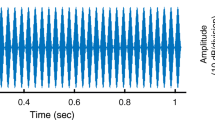Summary
The effect of the development of postauricular muscles on the postauricular myogenic response (PAR) was investigated in normal children and children with microtia. There were no differences between the PAR of normal children and that of the intact ear of children with microtia. The PAR obtained from the normal and microtic sides of children with unilateral microtia showed no significant differences as regards waveform, latency, threshold, or amplitude. Our findings suggest that the development of the postauricular muscle does not affect the PAR, and it seems difficult to explain the large individual variations in the PAR by intersubjective differences in muscle development.
Similar content being viewed by others
References
Bochenek W, Bochenek Z (1976) Post-auricular (12 msec latency) responses to acoustic stimuli in patients with peripheral facial nerve palsy. Acta Otolarnygol (Stockh) 81: 264–269
Buffin JT, Connell JA, Stamp JM (1977) The post-auricular muscle response in children. J Laryngol Otol 91: 1047–1062
Dobie RA, Norton SJ (1980) Binaural interaction in human auditory evoked potentials. Electroencephalogr Clin Neurophysiol 49: 303–313
Douek E, Gibson W, Humphries K (1973) The crossed acoustic response. J Laryngol Otol 87: 711–726
Flood LM, Fraser JG, Conway MJ, Stewart A (1982) The assessment of hearing in infancy using the post-auricular myogenic response: evaluation of an instrument which simplifies its detection. Br J Audiol 16: 211–214
Fraser JG, Conway MJ, Keene MH, Hazell JWP (1978) The post-auricular myogenic response: a new instrument which simplifies its detection by machine scoring. J Laryngol Otol 92: 293–303
Gibson WPR (1978) The myogenic (sonomotor) responses. In: Essentials of clinical electric response audiometry. Churchill Livingstone, Edinburgh London New York, pp 133–156
Grandis D DE, Santoni P (1980) The post-auricular response: a single motor unit study. Electroencephalogr Clin Neurophysiol 50: 437–440
Humphries KN, Gibson WPR, Douek EE (1976) Objective methods of hearing assessment: a system for recording the crossed acoustic response. Med Biol Eng 14: 1–7
Kiang NY, Christ AH, French MA, Edward G (1963) Postauricular electric response to acoustic stimuli in humans. Q Progr Rep Lab Electr MIT 68: 218–225
Meuman Y (1957) Congenital microtia and meatal atresia. Arch Otolaryngol 66: 443–467
Nishimura H (1974) The development of the microtia (in Japanese). J Plast Surg Jpn 17: 453–460
Streletz LJ, Katz L, Hohenberger M, Cracco RQ (1977) Scalp recorded auditory evoked potentials and sonomotor responses: an evaluation of components and recording techniques. Electroencephalogr Clin Neurophysiol 43: 192–206
Wood-Jones F, I-Chuan W (1934) The development of the external ear. J Anat 69: 525–533
Yoshie N, Okudaira T (1969) Myogenic evoked potential responses to clicks in man. Acta Otolaryngol [Suppl] (Stockh) 252: 89–103
Author information
Authors and Affiliations
Rights and permissions
About this article
Cite this article
Takagi, N., Suzuki, T., Matsuo, K. et al. The postauricular myogenic response in normal children and children with microtia. Arch Otorhinolaryngol 241, 95–100 (1984). https://doi.org/10.1007/BF00457923
Received:
Accepted:
Issue Date:
DOI: https://doi.org/10.1007/BF00457923




